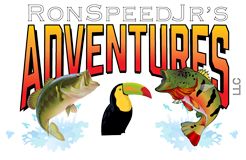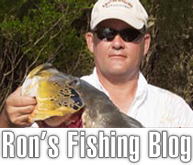Ron’s Fishing Tips and Stories: “Jungle Baby Tarpon”
 This week I am going to tell you another fishing story that was full of crazy but — believe me — real events. Lets call it Jungle Baby Tarpon.
This week I am going to tell you another fishing story that was full of crazy but — believe me — real events. Lets call it Jungle Baby Tarpon.
It was about 1981 when I got a call from Ed Weaver of Dallas. Ed owned Dallas North Taxidermy and I had taken him on a charter trip of 24 to Cuba a couple years earlier to catch the world record black bass. Ed called me to see if I was interested in catching hundreds of baby tarpon and some big snook in a remote jungle river. I asked him where this fantastic river was located. Ed said it was in Honduras and a friend of his had fished it a couple years ago and it was loaded with baby tarpon and snook.
Even though our primary business was Mexico bass fishing I had been looking to getting into the tarpon business. I had made a tarpon fishing trip to Costa Rica with my friend Chuck Pearce in 1977 and really liked it so I wanted to find a great place to take clients. Bill Langford of Ft. Worth had owned Karawalla Tarpon camp which was the best in the world until the communists confiscated his camp and ran him out of the country. He left the country with only the clothes on his back, but at least he made it out alive. That’s a great story for another day.
I told Ed I was ready and would invite a couple of friends plus pay his expenses to go with us. I invited Chuck Pearce of Corsicana, who had made several trips to Canada and Mexico with me and his ranch foreman, Joe Graves of Kerens. All of us left Dallas together and flew to Honduras. We landed in San Pedro Sula and were met by Ed’s friend who we called “Captain.” This man was an American, maybe in his 60s, and owned the Reef House on Roatan Island off the coast of Honduras. He had left the USA some 40 years prior and had never returned. Chuck, Joe and I guessed he had fled for some reason or another and couldn’t return.
We left the airport and got a hotel room for the night as we were to leave early the next morning for this secret jungle river. We left the dock just after daylight the next morning in the Gulf of Honduras for a 1 hour boat ride to the mouth of the river. The captain was a former ship captain and he said we must leave early to the river and return to the mouth of the river by 2 pm to avoid rough seas when the Easterlies began to blow. The boat was an old wooden boat that the captain said had a lot of dry rot and couldn’t take much pounding. He didn’t tell me that detail until we were half way to the river or I might not have gone!
We made the trip to the river with no problem and we eagerly started fishing for the hundreds if not thousands of tarpon and snook. After about an hour we hadn’t even had a strike and had moved quite a distance up the river. I asked the captain what he thought was wrong and he replied he simply didn’t know. Finally, Joe caught a baby tarpon — about 4 pounds — and that picked up our spirits. We kept going up river without a bite but we were enjoying the beauty of the jungle and all the animals, especially the monkeys and all the brightly colored parrots and other birds. The river was also beautiful with its clear water and occasional alligator and hundreds of funny sounding frogs.
Sometime after mid morning we came upon an old coconut plantation that was deserted save for a couple of men hacking on some coconuts. We waived to them as we fished on by them going farther and farther up river. Finally the old boat captain said we must return to the mouth of the river and begin our trip back to the dock before the Easterlies came up. We all were super disappointed as our long journey from Dallas had produced only one small tarpon.
When we arrived at the mouth of the river the Easterlies were already blowing a gale and the ocean was very rough. The captain said it was just too dangerous and we would have to spend the night in the jungle. Man oh man was I upset, but the anger turned very quickly to a mood of survival as I knew the jungle was full of big cats and lots of poisonous snakes. I suggested that we return to the old plantation and seek the advise of the two men cutting the coconuts. We fired up the engine and went up river as fast as we could to talk to the men.
We arrived to find them still hacking on the coconuts with machetes. Pulling the boat up to the bank, the captain got out and explained our situation. He found out that these men were from a village about 10 to 15 miles away and that they walked into the jungle and cut coconuts all week before returning to their village. The only way out was to walk, which would take several hours. They said that they would let us sleep in the jungle with them but they only had 2 hammocks and we would have to sleep on the ground. I didn’t like that idea one little bit.
I started walking around looking for a suitable sleeping place when I stumbled on a set of very narrow rail tracks that were covered with tall grass and weeds. I asked the men about the old tracks and they explained that many years ago the tracks were used to transport the coconuts out of the jungle when the plantation was still in operation. I then walked over to an old junk pile of cans and everything you can imagine and there was one of the old pump carts turned upside down. It had not been used in 15 to 20 years. I got Joe Graves and Ed to help me pull it out of the junk pile and turn it back upright. The wheels were rusted so badly they were froze up and wouldn’t turn. We got everyone to get in their tackle boxes and take out their reel oil and we began putting it on the wheels until we got them freed up.
We put the cart on the tracks and tried out the pump handle and — guess what — it worked! What comes next is beyond my imagination…. I hired the natives to pump us out of the jungle. Then we placed one igloo ice chest (24 quarts), Chuck, Ed, the “Captain,” and myself all on this very small cart. That is 6 grown men plus tackle boxes, rods and reels and the ice chest. There was no room for Joe, so he offered to jog along behind. I agreed to take his place when he got tired. We were headed for the jungle village about 10 miles away. It was probably 3 pm when we left the plantation.
Joe and I took turns jogging beside the cart, but we began to get tired after maybe 2 or 3 hours. By that time the 2 native men were exhausted and couldn’t pump anymore. I paid them some money and Joe and I began to pump the cart, stopping every now and then for a rest. Ed pumped a little but not much. The “Captain” and Chuck were just not physically able to pump.
Just as darkness set in, we arrived in a small village which looked almost like heaven to us. We were saved! There were a few cars parked on the street and one or two driving down the dirt street. I ran out into the street and stopped the first car that came along. Guess what! It was a yellow Chevy II just like the one I stopped in Obregon, Mexico a few years before.
I told the driver I would give him $50 dollars to take us to San Pedro Sula. He said he couldn’t fit us all into his car, but I assured him we were experts at fitting into small spaces. We all crowded into the car, sitting on one another’s laps for the one hour ride to the city.
This ends part one of our Honduras adventure. Next week I’ll wrap up this story. We were still in for some adventures that were pretty funny–in retrospect!
Good luck with your fishing and wear that lifejacket.

